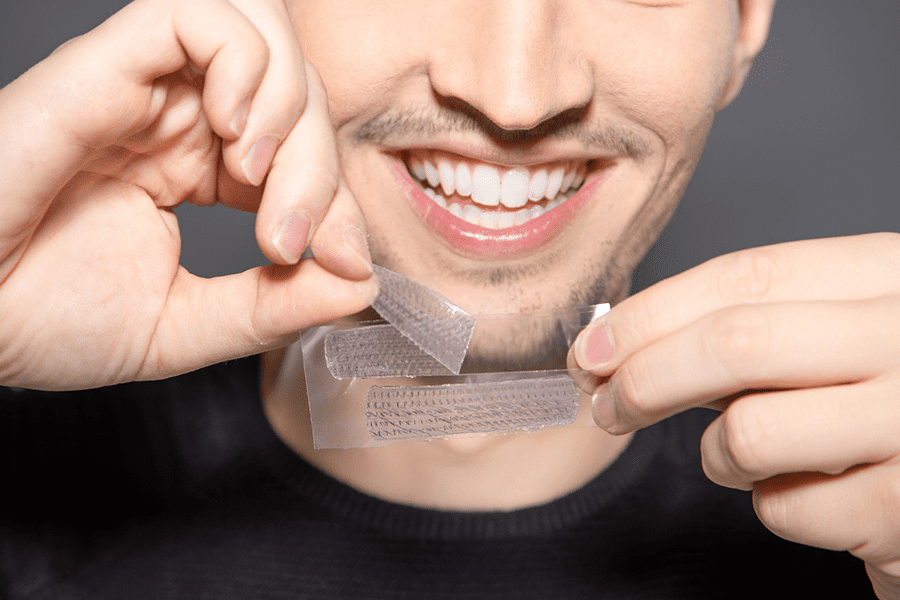A bright, white smile is a boost of self-confidence for most people. But over time, factors like aging, lifestyle habits, and even your diet can contribute to teeth discoloration.
Because of this, many people turn to products such as teeth whitening strips that promise a whiter smile in a short amount of time.
Before investing in them, it’s a good idea to do your research. You may be surprised by what you don’t know about teeth whitening strips.
What are teeth whitening strips?
Teeth whitening strips are thin, flexible pieces of plastic coated with a whitening gel, usually containing some sort of bleaching agent, such as hydrogen peroxide or carbamide peroxide.
Teeth whitening strips are designed to adhere to the surface of your teeth and gradually lighten stains and discoloration over time. Most strips are worn for no more than 30 minutes per day, and treatment time can last anywhere from seven to 14 days.
Pro tip: Be sure to carefully review the instructions provided with the whitening strips before applying them.
Do teeth whitening strips work?
If you’re wondering whether teeth whitening strips work, the short answer is yes, they can be effective. But it’s important to manage expectations and weigh the pros and cons.
At-home whitening strips are typically designed to lighten the color of your teeth. If you have heavily stained teeth, they may not be as immediately effective. This is because over-the-counter whitening products sold at grocery stores or pharmacies contain lower concentrations of bleaching agents compared to the professional-grade treatments used by dentists.
So, if you have very dark or discolored teeth, especially if medications or trauma are the cause, teeth whitening strips may not be the best option.
Note: Before starting any new whitening treatment, it’s always a good idea to consult your dentist. They can help you choose the safest and most effective option based on your individual needs.
Can teeth whitening strips damage teeth?
While teeth whitening strips can be an effective way to brighten your smile by a few shades, it’s important to be aware that the treatment may come with some risks.
Some people experience teeth or gum sensitivity while using whitening strips. This is usually caused when the bleaching agents penetrate through the enamel and reach the dentin, which can irritate the nerves inside the teeth.
If you experience any sensitivity, take a break from treatment. If the problem continues, talk to your dentist for the best next steps.
Do teeth whitening strips work on dental prosthetics?
Teeth whitening strips are designed specifically for natural teeth and won’t be effective on veneers, crowns, caps, or other dental prosthetics. Talk with your dental team for more information about whitening these types of dental prosthetics.
At-home alternatives to teeth whitening strips
If teeth whitening strips aren’t a good fit for you, there are other tips that you can try to reduce teeth discoloration.
Limiting food or beverages that are dark in color, such as red wine, coffee, and tea, can help prevent staining. Additionally, keeping a good oral health routine by brushing twice a day, flossing daily, and seeing a dentist regularly will keep your teeth shining and healthy. Finally, quitting smoking and other tobacco products is a great choice with plenty of other health benefits aside from whiter teeth.
Professional teeth whitening options
People who are looking for a dramatic and significant change to the color of their teeth should seek professional whitening treatments from their dentist.
A professional teeth whitening treatment is a cosmetic dental procedure performed or supervised by a dentist to safely and effectively lighten the color of your teeth. It typically involves high-concentration bleaching agents used to penetrate enamel and break down stains at a molecular level. This can either be done in the dental office through manual application or in your home with custom whitening trays and specific instructions from your dentist.
Another professional-grade whitening option is enamel microabrasion, which involves applying an abrasive or acidic mixture to the surface of the teeth to gently remove superficial stains. Because it affects the outer layer of enamel, this procedure must be performed by a dental professional to avoid potential damage to your enamel, gums, or surrounding tissues.
The bottom line on teeth whitening strips
Teeth whitening strips can be a convenient and affordable way to enhance your smile, but they’re not a one-size-fits-all solution. Understanding how they work, their limitations, and potential risks can help you make an informed decision.
Whether you choose at-home strips or professional treatments, be sure to use products that are approved by the American Dental Association and consult your dentist to ensure safe and effective results tailored to your needs.



